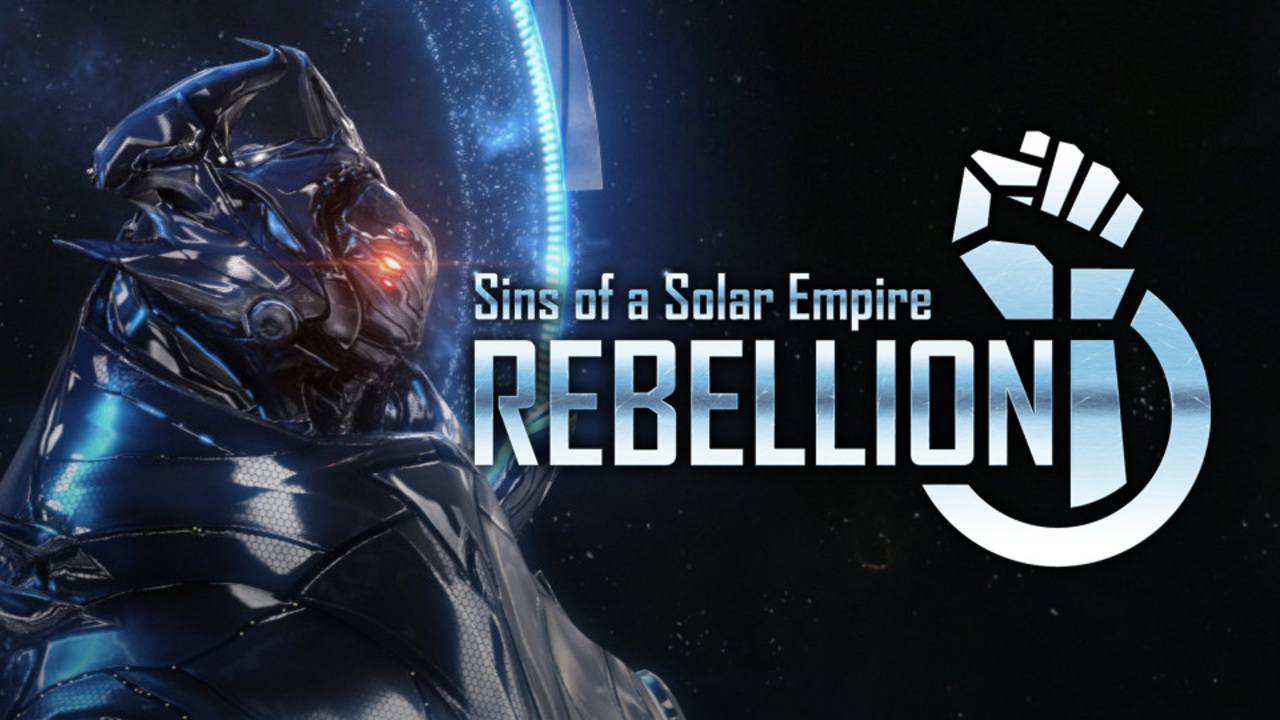Welcome to a cosmos brimming with conflict and diplomacy, where strategy meets 4X grandeur in real time. Sins of a Solar Empire: Rebellion is a game developed by Ironclad Games and published by Stardock Entertainment. It challenges the player to mesh the tactical finesse of real-time strategy games such as Starcraft with the large-scale strategic depth of 4X games like Civilization.
Though it presents a steep learning curve, those willing to conquer it will find the game to be a treasure trove of space combat, real-time strategy, and empire management. In this guide, we’ll help you understand the game’s basic features, provide detailed gameplay advice, and offer insights into modding and multiplayer.
Defining Features of the Game
- Single Player and Multiplayer Features: Sins of a Solar Empire offers a variety of gameplay modes and maps to cater to every type of gamer. You can play solo or with up to 10 players, involving a mix of human players and AI. LAN multiplayer is also supported for local network games.
- Modding and Mapmaking Support: The game further extends its replay value with robust modding support and mapmaking capabilities. These tools enable players to add fresh content, thus continually enriching the game experience.
- Unique Races and Styles of Play: Adding to the complexity, the game hosts three distinct races, each offering two subfactions with unique gameplay styles.
Lacking Features of the Game
While Sins is expansive, it does lack certain features. It does not offer a campaign mode, and while there is a backstory told through introduction videos and in-game texts, it lacks a narrative-driven, scripted mission path. Additionally, there’s no matchmaking support, meaning that the range of skill levels you might encounter in multiplayer can vary widely.

The Three Types of Sins Players
Sins players can broadly be classified into three categories. The first category includes those who mostly engage in single-player or occasional LAN/Online multiplayer with friends. The second category expands on the first, with players who not only play solo or with friends but also make use of user-generated content like mods or custom maps. Lastly, we have those who primarily engage in competitive online multiplayer matches against human opponents.
Getting Started with the Game
Navigating the Tutorials
Embarking on your journey in Sins begins with hitting the single-player button on the main menu. Here, you can also customize your in-game player name, color, symbol, and faction pictures. From there, it’s onto the tutorials. Although they might seem basic for such a complex game, they provide a useful introduction to navigating the game environment, constructing factories and defenses, colonizing planets, and honing your empire development and diplomacy skills.
Diving into Gameplay
Once you’ve completed the tutorials, you’re likely still to be finding your footing. From here, you can choose to jump right in and challenge an easy AI on an appropriate map or try a premade map and disable all but one easy AI.
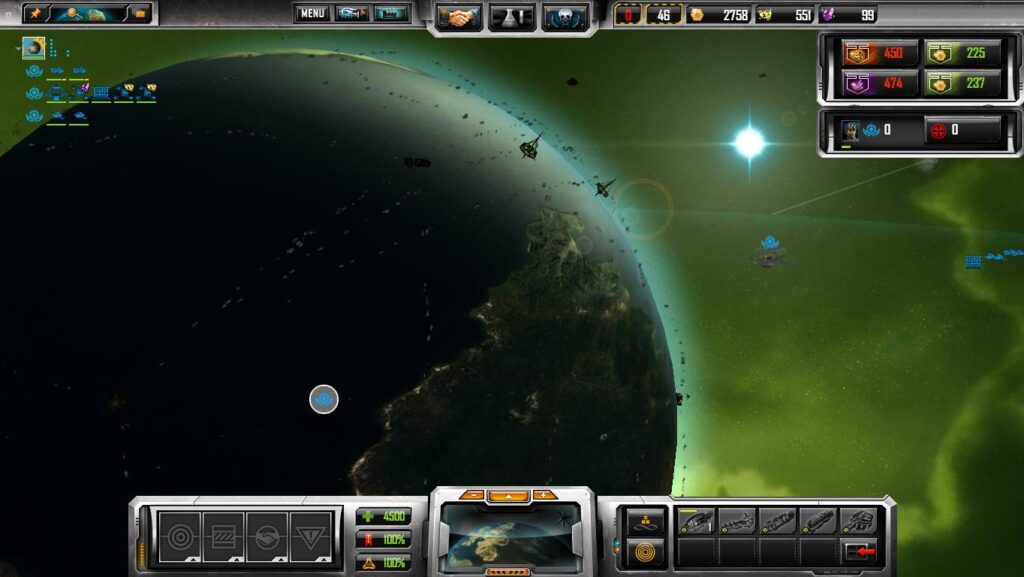
Tips for the First Game
For your first game, I’d suggest using all fast or faster speed settings, disabling pirates, and setting locked teams and allied victory. To maintain a manageable level of complexity, it’s best to leave other victory options disabled for your first few rounds.
Basic Gameplay: Establishing Your Dominion in Sins of a Solar Empire: Rebellion
In Sins of a Solar Empire: Rebellion, most games begin with a familiar setup. Players choose their faction and start on a developed Terran or occasionally desert homeworld.
Choosing a Faction
Learn more about choosing a faction in Sins of a Solar Empire: Rebellion in our detailed guide.
If the quickstart option is enabled (which is recommended), players will have a frigate factory, a capitalship factory, and resource extractors at their disposal. The primary objective is to establish dominance in the solar system by capturing opponents’ planets until they either have none left or surrender. However, there are additional victory options available if enabled, such as destroying the enemy’s flagship, achieving technological superiority, or diplomatic conquest. For the purposes of this section, we will assume that no extra victory options are enabled.
Building the Capitalship
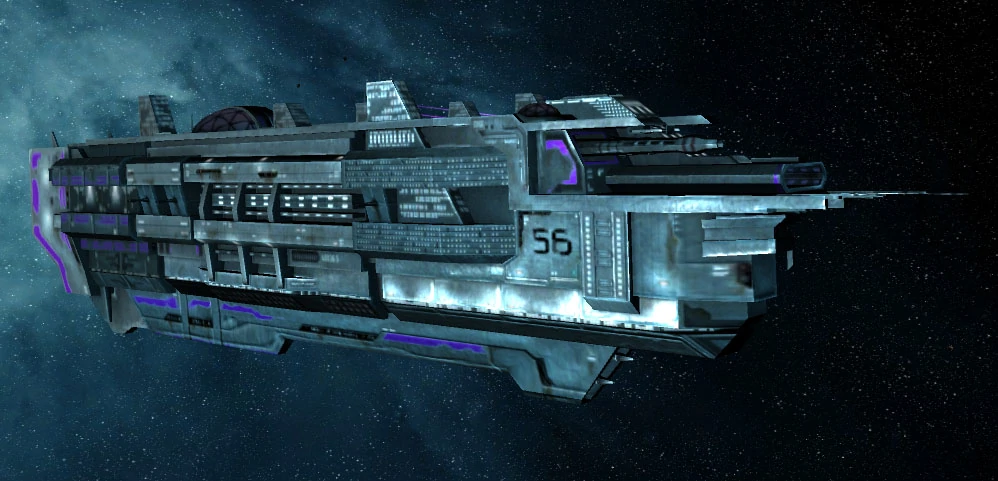
When starting out, it is advisable to focus on building your faction’s colony capitalship until you become familiar enough with the game to experiment with different strategies. The colony capitalships for each race (Akkan Battlecruiser for TEC, Progenitor Mothership for Advent, and Jarrasul Evacuator for Vasari) are highly valuable ships that remain useful throughout the game. They possess the power to clear most planets, colonize them, and offer a range of abilities that provide fleet support or debuffs. Once the capitalship is constructed, select the “Colonize” ability from the ability menu to initiate colonization.
Research Labs, Scouts, and Starting Militia
While waiting for the capitalship to be built, it is recommended to construct one or two research labs early on (ideally, one for military research and one for civic research), deploy scouts to explore nearby planets, and build two or three light frigates. Each colonizable planet in the game is guarded by militia, small groups of units that act as deterrents to prevent rapid expansion. These militia units do not attack or grow stronger over time; they simply serve as obstacles. When sending colonizers to new planets, prioritize asteroids and dwarf planets as they are lightly defended, inexpensive to develop, and provide crucial resource income. Always eliminate siege frigates around neutral planets first, as they pose a threat to your newly established colonies, while other enemy vessels are only a concern for your ships.
Colonizing Planets

Upon colonizing a new planet, it is crucial to immediately develop it to avoid suffering from negative income due to underdevelopment. Click on the planet, select the green planet development button, and choose the “Population development” option. Population upgrades remove the tax income penalty associated with underdevelopment and increase the planet’s population, thereby boosting your tax income.
Other upgrades allow for additional planet slots, provide access to unique bonuses or powerful ancient artifacts, and enable the construction of more logistical or tactical structures. Asteroids, dead asteroids, pirate bases, and dwarf planets require only one population upgrade to generate positive tax revenue, while all other planets require two upgrades. Additionally, prioritize the construction of resource extractors on each planet to maximize mineral income.
Planet Management
Learn more about planet management in Sins of a Solar Empire: Rebellion in our detailed guide.
The next tier of planets to target are Ice and Volcanic planets. These planets are more heavily guarded, but your colony capitalship can typically defeat the defenders on its own if necessary. However, specific research is required to colonize these planets. “Volcanic” and “Ice Colonization” research can be unlocked by building two civic research labs and researching these technologies in the Civic tree. If your scouts discover Ice or Volcanic planets near your starting position, consider constructing civic labs on your asteroids or dwarf planets until you have two labs available for research.

The third tier of planets includes additional Terran and Desert planets. These planets possess the highest population levels but require no research to colonize. They are heavily defended, often by formidable heavy cruisers. Taking these planets will likely require support from your colony capitalship, and it is recommended to maximize your starting fleet supply before attempting to conquer them.
Growing Your Fleet
As your empire expands and grows, you will eventually reach a point where you can support a larger fleet. To achieve this, navigate to the “Fleet Logistics” tab in the research menu. Here, you can research additional fleet supply and command points for capitalships and titans. However, keep in mind that researching larger fleet sizes will increase your “fleet upkeep” permanently, even if you have no ships. It is essential to carefully time these research upgrades, ensuring that your economy can sustain the increased upkeep cost. Ideally, maintain a fleet size that is sufficient for defending your empire without being unnecessarily large. Nevertheless, the initial upgrades to fleet supply have relatively minor upkeep costs, so do not hesitate to pursue them as you approach the fleet supply limit.
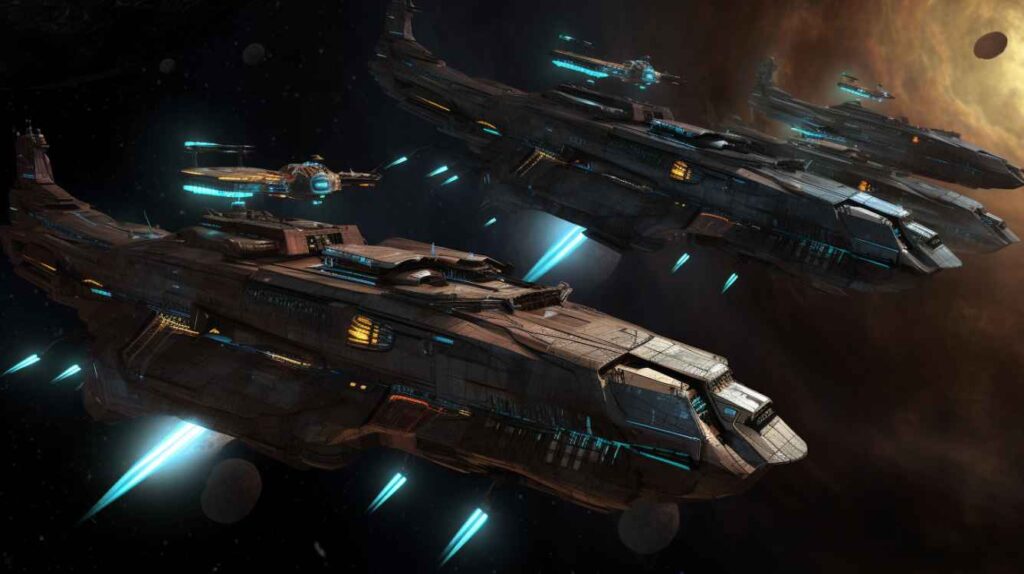
Start Trading
Once you have established several planets, trade becomes a lucrative source of income. Trading becomes available after building two civic labs for the TEC, three for the Advent, and four for the Vasari. Trading offers bonus income based on the length of your “trade chain.” It is advisable to start developing trade routes once you have acquired a handful of planets and are not under immediate threat. Allocate most of your planet’s logistics slots to trade once you have obtained the necessary research labs.
Culture and Allegiance
Culture is another important civic mechanic in the game. By constructing a “Culture Center,” you can initiate cultural influence that spreads to other planets. Friendly culture raises a planet’s “Allegiance,” resulting in increased credit and resource generation. Conversely, enemy culture lowers allegiance, reducing income, and, if allegiance reaches zero, leading to loss of control over the planet and prevention of colonization. Capitalships can repel enemy culture, and with research, culture can provide combat bonuses to friendly ships within its range. Since one culture center can affect multiple planets, it is generally unnecessary to build one on every planet. Consider constructing a culture center every few planets to avoid diminishing economic returns, as trade ports do not have this limitation.
Enemies
As your empire expands, you will inevitably face attacks from enemy players or pirates (if enabled). Starbases, large and upgradeable space stations deployed from Constructor Frigates (or colony frigates for Vasari), serve as the most potent defense structures at your disposal. However, they are costly and should only be constructed at strategic chokepoints. It is important to note that starbases alone cannot replace a well-equipped fleet.

Repair bays, which can heal defending ships during combat or support each other, are critical minor structures. A well-designed defense system may consist of a starbase, 3-5 repair bays, and possibly a hangar for fighter support and abilities. It is also beneficial to position research labs and other civic structures nearby to maximize the starbase’s coverage. While starbases can be bypassed by enemy ships, they will inflict damage on any ship attempting to do so, weakening them. However, AI opponents typically do not bypass starbases.
By following these strategies and mastering the basics of gameplay in Sins of a Solar Empire: Rebellion, you will be well on your way to establishing a formidable and prosperous empire. Now lets talk about multiplayer.
Units in SOASE

1. Combat Units
This section provides a quick overview of each general type of combat unit in Sins of a Solar Empire: Rebellion. These units include frigates and capital ships that share common characteristics and roles. For more detailed information, you can hover your mouse over a unit in the build menu to view a tooltip displaying its strengths and weaknesses.
- Light Frigates (LFs): These frigates are the basic combat units that can be built without any research. They excel against anti-fighter frigates, support cruisers, and carrier cruisers, but are weak against Long Range Frigates (LRFs). Light Frigates are moderately armored and armed, and their speed gives them an advantage. However, they can be easily countered if the enemy spams LRFs. Upgrading Light Frigates with abilities to hinder support cruisers can be beneficial, particularly for the Advent and TEC factions.
- Corvettes: Introduced in the Rebellion expansion, corvettes serve as a hybrid between fighters and frigates. They do not require carriers and are fast and light, but vulnerable to anti-fighter frigates. Corvettes are strong against Long Range Frigates, Siege Frigates, Antistructure Frigates, and even titans when deployed in large groups. They are excellent ships for early expansion. Additionally, corvettes have a chance to apply faction-specific debuffs with each attack. While Vasari corvettes require higher tech and more supply, Advent and TEC corvettes should be researched and built as soon as possible due to their speed and bonus against siege frigates.
- Long Range Frigates (LRFs): LRFs are slow, mid-tier frigates with long-range capabilities. They counter Light Frigates and are effective against capital ships when deployed in groups. However, they are weak against corvettes, fighters, and heavy cruisers. TEC and Vasari LRF units are easily accessible and function as excellent focus fire units, especially if the enemy is not spamming Corvettes. The Advent Illuminator, higher up on the tech tree, can fire at a target forward and on both flanks, making it less focused on single-target damage. While LRFs have unlockable abilities, they do not have a specific theme or vital importance.
- Anti-fighter Frigates (Flak): These frigates, also known as Flak frigates, possess heavy armor but light weaponry. They are strong against fighters, corvettes, and bombers to a lesser extent. Flak frigates can fire on strikecraft and engage targets in any direction. While their light weapons are not effective against heavier ships, their resilience against everything but light frigates makes them valuable filler units, particularly for the Advent faction. To maximize their damage against non-fighter units, deploy flak frigates in the center of an enemy formation to engage up to four targets simultaneously.
- Anti-structure Cruisers: These cruisers have the longest range in the game but can only attack structures and starbases, not ships. The TEC Orgorv serves as a focus fire unit to overwhelm enemy defenses quickly. On the other hand, the Advent Adjudicator can simultaneously fire at three targets but deals less damage to each. The Vasari faction does not have an anti-structure cruiser. In multiplayer matches, human players typically rely on carriers with bombers instead of anti-structure cruisers, as bombers are effective against both starbases/structures and other units. Anti-structure cruisers find a niche in the mid-game when deploying bombers in sufficient numbers may be challenging due to limited economy.
- Heavy Cruisers: These late-game units are durable and well-armed, but have short range and high cost. Heavy cruisers excel against long-range frigates and can defeat other frigates and capital ships in one-on-one combat or when deployed in groups. However, they are highly vulnerable to bombers. Considering their supply cost, other combat frigates usually offer more firepower. If you decide to use heavy cruisers, ensure you have ample fighter and repair support or capital ships with anti-fighter abilities like the Halcyon Carrier to protect against bombers.
- Fighters: Fighters are fast, small interceptors deployed from carriers, capital ships, titans, structures, or starbases. They remain within the gravity well of the host unit and are periodically replenished for free as they are destroyed. Fighters excel against bombers, long-range frigates, and siege frigates but are weak against other targets. Flak frigates deal heavy damage to fighters. Deploy fighters when you have the advantage in killing power, such as from Titans or heavy cruisers, and primarily want to protect those assets from bombers. Fighters can also counter corvette or LRF spams and be utilized in hangar defenses to eliminate siege frigates. It’s worth noting that the term “fighters” can also refer to strikecraft in general, encompassing fighters and bombers, not just the fighter unit itself.
- Bombers: Bombers are slower strikecraft that serve as the backbone of many late-game fleets. They inflict significant damage against structures, starbases, capital ships, and heavy cruisers but are highly vulnerable to fighters. Contrary to popular belief, flak frigates can attack bombers, although they are not a strong counter. Bombers are often employed to destroy titans from a safe distance, preventing the enemy titan from gaining experience by destroying frigates. Carriers can safely deploy bombers out of range of enemy defenses.
2. Support Units
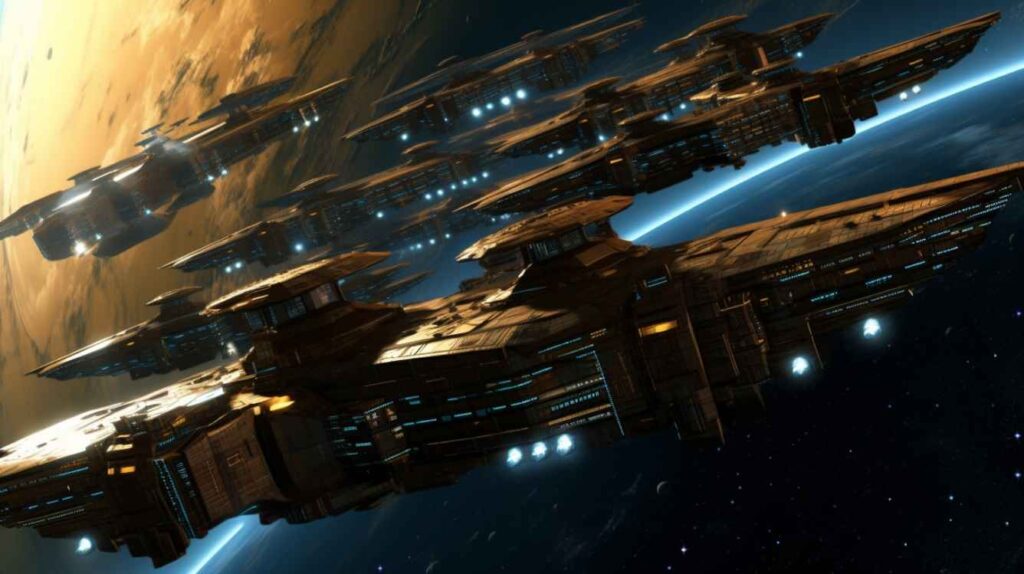
- Scouts: Scouts are lightly armed and armored units designed for fast exploration of enemy territory. They can utilize the “Explore” ability to automatically jump to unknown planets, prioritizing those that haven’t been visited for the longest time. Scouts are also effective at revealing mines and work well alongside flak frigates and fighters to clear minefields. With research, scouts can gain immunity to phase jump blocking and employ various means to spy on planets without physically being present. Vasari scouts have the additional capability to capture neutral resource extractors in uncolonizable planets.
- Colony Frigates: These relatively expensive and weak ships serve the purpose of colonizing planets and capturing resource extractors on uncolonizable planets. While armed, they are extremely vulnerable, requiring the clearing of planets with other ships before sending in colony frigates for colonization. Building one or two of these frigates early on is advisable if a colony capital ship is not constructed at the beginning of the game. Notably, the Vasari colony frigate differs slightly, as it cannot capture extractors (this task falls to the Vasari scout), but it serves as the platform for deploying Vasari starbases once the relevant research is completed. This provides a bonus by enhancing the utility of the colony frigate, and the Vasari starbase constructors are cheaper compared to those of other races.
- Siege Frigates: Siege frigates are fragile and lightly armed ships designed specifically for bombarding enemy planets. Due to their considerable cost, deploying them should only be considered when the gravity well is under control.
- Starbase Constructors: Starbase constructors are unarmed and expensive units used for deploying starbases. As cruisers, constructors can enter any gravity well, allowing starbases to be deployed in neutral and even enemy-controlled gravity wells. It is worth noting that the Vasari do not possess a starbase constructor; they construct starbases from their colony frigates.
- Carrier Cruisers: These expensive and slow cruisers serve as the primary means of mass-producing strikecraft. Carrier cruisers offer flexibility, allowing the switch between fighters and bombers as needed. However, they require time to produce strikecraft and are ineffective in small numbers. Deploying numerous squadrons becomes highly effective, making it challenging for anti-fighter units to keep up with the sheer volume of strikecraft. Unlike capital ships, titans, and starbases, carrier cruisers consume antimatter to produce strikecraft, necessitating caution when engaging antimatter-draining units or frequently jumping carriers, as antimatter reserves can be depleted. Each carrier cruiser carries two squadrons, with the exception of the Advent carrier, which is more expensive but can accommodate three. Additionally, the Advent carrier can deploy mines.
- Support Cruisers: Support cruisers encompass a diverse range of ships, primarily valued for their special abilities. These cruisers, alongside each faction’s capital ships and titans, contribute to distinct tactical approaches for each race. While typically present in limited numbers, their importance outweighs their quantity. Each faction possesses one healing-oriented frigate, such as the TEC’s Hoshiko Robotics cruiser, and one frigate with offensive-oriented abilities, such as the Vasari Subverters that can disable groups of enemy frigates. Each cruiser starts with one unlocked special ability, while additional abilities can be unlocked through research.
- Minelayer: A unique ship exclusive to the Vasari, the minelayer’s sole purpose is to deploy explosive or gravity mines in any gravity well it enters. The TEC deploys mines by constructing them like structures, while the Advent deploys mines from carriers and hangar defenses.
- Envoy Cruisers: Unarmed units intended for ally support, envoy cruisers are sent to allied players to boost relations. Envoys can temporarily make themselves invulnerable using the Diplomatic Immunity ability. Through research, envoys can provide bonuses to allies, facilitating faster relationship improvement. Each envoy can grant a maximum of +2 relations and should be deployed at different allied planets. Envoys are primarily used to solidify alliances with AI players and enhance relationships to establish pacts. With the Minor Faction DLC, envoys gained an additional function: bringing Minor Factions to their side. By sending envoys to unclaimed Minor Factions and using their Goodwill ability on the planet, players can recruit the Minor Faction, gaining a share of its income and access to special abilities. When the envoy stops using Goodwill, the planet reverts to neutral, allowing for later conquest or capturing of Minor Factions from enemies by relocating or eliminating the envoy.
3. TEC Capitalships:
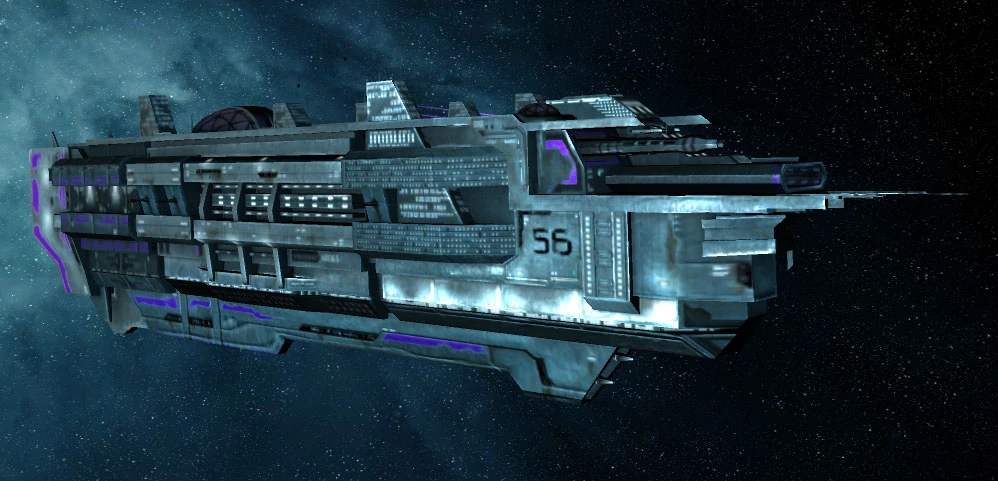
- Kol Battleship: The Kol Battleship is a mediocre capitalship overall. It is primarily useful for countering swarms of strikecraft, particularly from the Advent faction, due to its Flak Burst ability. Finest Hour can be a useful ability, but Adaptive Force Field and Gauss Rail Gun are generally not very impactful. The Kol Battleship has high antimatter consumption, so it is challenging to sustain its abilities unless paired with a Dunov Battlecruiser with Flux Field.
- Sova Carrier: The Sova Carrier is not just a carrier but also a formidable early-game brawler and rusher. It is an excellent choice as a first capitalship when rushing or as a second capitalship in other scenarios. The Sova starts with three strikecraft squadrons, making it effective in the early game before you can deploy a large number of flak frigates and fighters. Embargo, one of its abilities, is particularly useful for rushing, as it allows you to disrupt the enemy’s economy. However, the Sova Carrier’s combat abilities are not area-of-effect (AoE), so its effectiveness diminishes as fleets grow larger. Late game, there are better capitalships to build, but it can still provide value with its Embargo ability on factory worlds or by boosting production with its ultimate ability.
- Akkan Battlecruiser: The Akkan Battlecruiser serves as the colonization capitalship for the TEC faction. It is an excellent capitalship with various tricks up its sleeve. For new players, it is recommended to build a colony capitalship as their first choice until they become more comfortable with different expansion or rush tactics. The Akkan’s colonize ability is among the best across all three races, offering free extractors and a bonus to resource collection income for a strong economic head start. It also has the Targeting Uplink passive ability, which boosts the range and accuracy of nearby allies, making it useful for supporting flak frigates, long-range frigates (LRFs), starbases, and turrets. Ion Bolt can disable enemy abilities, and Armistice is a powerful ability that can disable weapons and make ships invulnerable, providing tactical options such as retreating from a losing battle or bypassing fortified enemy planets.
- Dunov Battlecruiser: The Dunov Battlecruiser is a weak ship on its own, particularly in the early game, but its strength lies in its area-of-effect (AoE) abilities, which become more valuable as fleets grow larger, especially with the introduction of titans. Magnetize is a useful interrupt ability that disables enemy abilities and damages nearby strikecraft. Shield Restore provides instant shield point restoration and is effective in keeping important capitalships and titans alive. EMP is a crucial ability for depleting the antimatter of enemy titans, rendering them unable to use their abilities. Flux Field, the ultimate ability of the Dunov, greatly reduces antimatter costs for non-ultimate abilities, allowing for sustained combat without significant antimatter drain.
- Marza Dreadnought: The Marza Dreadnought is the most powerful combat capitalship in the TEC arsenal. It excels as a battleship rather than a siege ship. With high base forward weapons damage, it is effective at focus fire. Radiation Bomb is an area-of-effect (AoE) attack that damages multiple targets, although its damage output may be limited. Incendiary Shells, a passive ability, inflicts damage over time, but its effectiveness is debatable. The Marza’s ultimate ability, Missile Barrage, is a devastating attack that fires 25 volleys of missiles at all targets in range, dealing significant damage. It is recommended to move fleets away or use interrupt abilities when facing a Missile Barrage. The Marza Dreadnought is a potent asset and can be a game-changing unit, particularly at level 6.
- Corsev Battlecruiser: The Corsev Battlecruiser is a unique capitalship with its focus on the “Boarding Party” ability. Boarding Party allows the Corsev to deal heavy damage to a single frigate, capturing it if it would have been destroyed and healing it to half health instead. Salvage Operations, a passive ability, provides healing to the Corsev whenever a ship is destroyed nearby, making it one of the best “tanks” in the game. Demolition Teams can deal significant damage to enemy targets at the cost of sacrificing one of your frigates. The ultimate ability, Elite Crews, grants bonuses to allied capitalships. While the Corsev Battlecruiser is not particularly game-changing, it can be a valuable asset in certain situations.
4. Advent Capitalships:
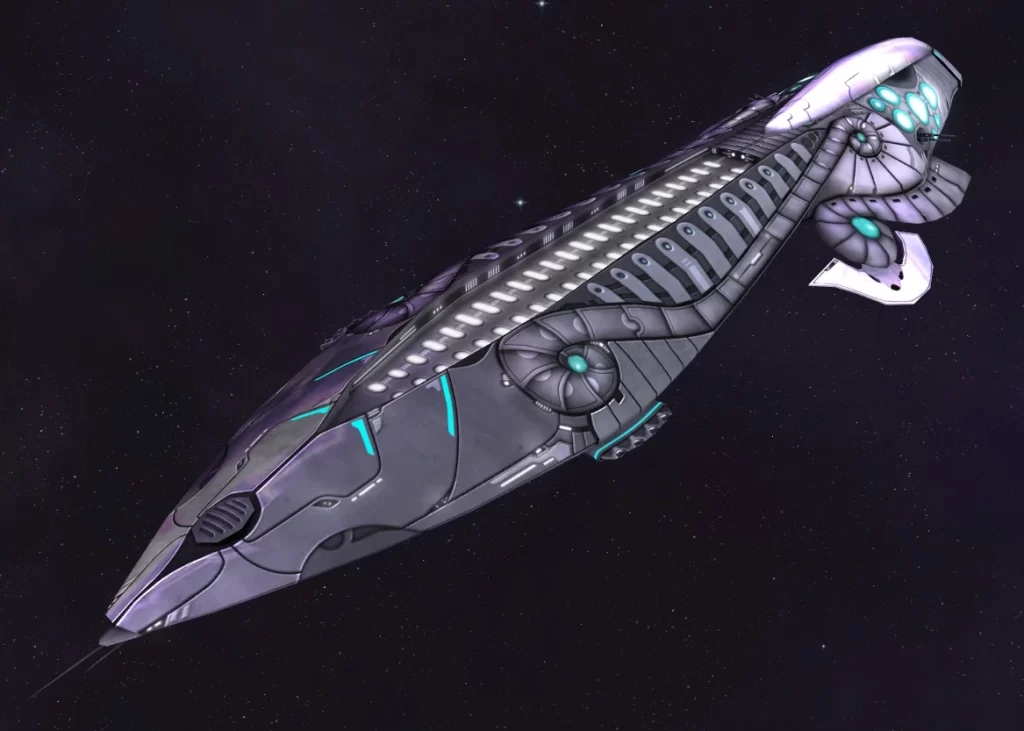
- Radiance Battleship: The Radiance Battleship is primarily used as a capitalship/titan hunter. Its key ability, Detonate Antimatter, drains the antimatter of enemy titans and disables abilities of non-titan ships. Energy Absorptive Armor is a useful passive ability that increases durability and provides antimatter regeneration. Animosity allows the Radiance to tank for the fleet, but its effectiveness is limited against human players due to the target cap. Cleansing Brilliance is a high-damage ability that can target a single enemy or multiple targets near the beam. While not as powerful as Missile Barrage, it is still worth obtaining when the Radiance reaches level 6.
- Halcyon Carrier: The Halcyon Carrier is a strong capitalship with excellent carrier capabilities. It starts with three strikecraft squadrons, allowing it to quickly deal with militia and handle early-game frigates effectively. Bombers deployed from the Halcyon are particularly useful against heavy cruisers around neutral terran and desert planets. Amplify Energy Aura is a valuable passive ability that increases the rate of fire for all energy weapons in the fleet, providing a damage bonus. Telekinetic Push is an anti-strikecraft ability that slows down and throws enemy strikecraft out of range, reducing their damage output. Anima Tempest, the ultimate ability, creates additional strikecraft and enhances the survivability of the carrier’s strikecraft. The Halcyon is a versatile capitalship that can be a strong choice as the first or second capitalship in a fleet.
- Progenitor Mothership: The Progenitor Mothership is the core of the Advent “Battleball” tactic and serves as a colony capitalship. It is an essential ship for any Advent player. Its colonize ability provides a planet upgrade discount and offers advantages in early-game economics. Shield Regeneration is a channeling ability that restores shields to all allied frigates in range, making it effective when combined with Guardian support cruisers. Malice is a powerful ability that deals damage to a group of ships whenever any of them are damaged. It requires practice to use effectively. The ultimate ability, Resurrection, allows the Progenitor to restore the level of a destroyed capitalship. This unique ability enables the Advent to view high-level capitalships as expendable and provides strategic advantages in the late game.
- Rapture Battlecruiser: The Rapture Battlecruiser is a valuable support cruiser that is worth building in the mid to late game. Its Vertigo ability is a powerful damage debuff, reducing the damage output and rate of fire of enemy ships within its radius. This ability synergizes well with the Coronata titan and can make it difficult for enemy fleets to destroy Advent ships. Vengeance allows the Rapture to damage any ship that attacks a targeted ally, discouraging focus fire. Concentration Aura is a useful passive ability that increases the damage of strikecraft owned by carriers within its range. Domination enables the instant capture of an enemy frigate, providing an interesting utility but not necessarily game-changing. The Rapture Battlecruiser can be a valuable addition to any fleet.
- Revelation Battlecruiser: The Revelation Battlecruiser is a capitalship that offers limited usefulness compared to other Advent options. Reverie is its best ability, which disables an enemy ship for a significant period. However, the effect is canceled if the target takes too much damage. Guidance reduces the cooldown of special abilities, but its value is limited outside of Advent titans. Clairvoyance instantly scouts a planet, but scouts are relatively inexpensive, making this ability less impactful. Provoke Hysteria, the ultimate ability, affects only planets and allows for rapid damage against heavily fortified ones. While it can be useful for planet destruction, it lacks versatility and is less game-changing compared to other Advent capitalships.
- Discordia Battleship: The Discordia Battleship is a unique and versatile ship. It is fragile but offers offensive power. Fracture is an area-of-effect (AoE) debuff that reduces enemy armor, making it easier to destroy targets. Psionic Scream is an AoE damage ability that deals more damage to “Fractured” enemies, including Corvettes. Lethargy reduces weapon and ability cooldown times of a single target, which can be effective against enemy titans. Revenge from Beyond causes nearby frigates to inflict extra damage when destroyed, potentially creating devastating chain reactions. The Discordia Battleship is a powerful capitalship, particularly in offensive operations.
5. Vasari Capitalships:
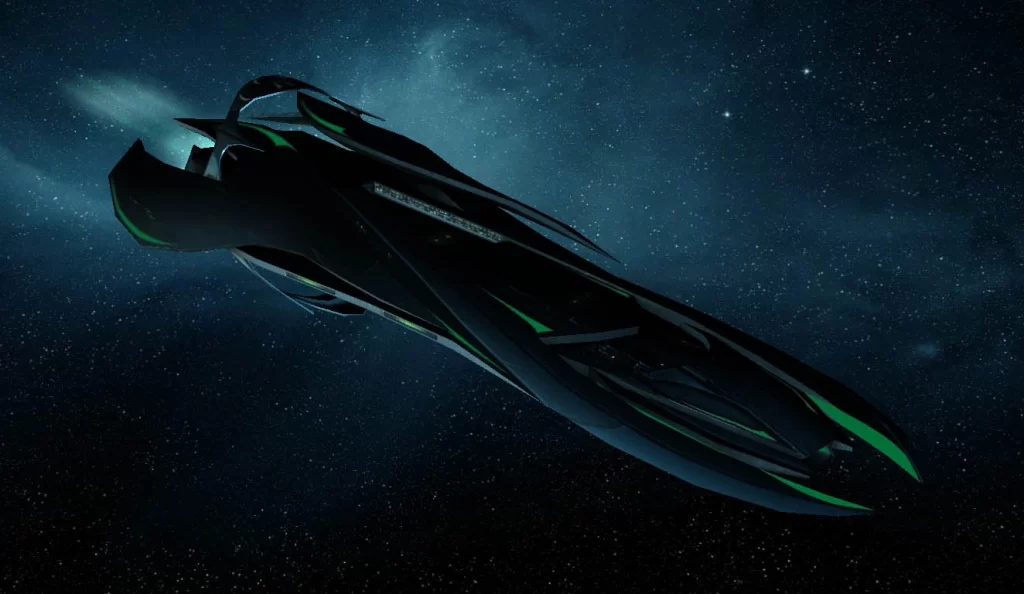
- Kortul Devastator: The Kortul Devastator is widely regarded as one of the best battleships in the game. It excels as an anti-capitalship and anti-titan vessel. Power Surge is an amazing ability that increases rate of fire and regenerates shields, making it one of the toughest capitalships to kill. Disruptive Strikes, a passive ability, has a chance to remove antimatter and increase ability cooldowns on targets struck by the Kortul’s energy weapons. This synergizes well with Power Surge, allowing for sustained combat and debilitating enemy capitalships. Jam Weapons is an anti-strikecraft ability that prevents enemy fighters from attacking near the Kortul, making it resilient against bomber strikes. Volatine Nanites, the ultimate ability, increases vulnerability to damage and triggers area-of-effect damage upon nearby ship destruction. The Kortul Devastator is a versatile and powerful capitalship.
- Skirantra Carrier: The Skirantra Carrier is a versatile carrier capitalship. Scramble Bombers is its main offensive ability, instantly creating bomber squadrons that can overwhelm enemy anti-fighter defenses. Repair Cloud is an area-of-effect ability that restores hull points to nearby allied frigates, making it a valuable support option. The ultimate ability, Replicate Forces, allows the Skirantra to combine nearby “nanite swarms” into a Greater Nanite Storm, providing stronger stats and prolonged duration. While the Skirantra is a solid choice as an opening capitalship, it faces competition from carrier cruisers later in the game due to the difficulty of leveling multiple capitalships and the higher cost of the Skirantra.
- Jarrasul Evacuator: The Jarrasul Evacuator serves as the Vasari colony capitalship. While it is less focused on early-game economics compared to other races, it compensates with increased hitting power. The colonize ability grants temporary construction frigates, which are useful for quickly building extractors and defenses on key planets. Nano Disassembler is the Jarrasul’s standout ability, providing heavy damage over time that ignores shield mitigation and reduces enemy armor. Gravity Warhead slows down enemy ships and prevents them from phase jumping, making it useful for pursuing fleeing fleets. Drain Planet allows the Jarrasul to extract resources from enemy planets while inflicting damage. The Jarrasul Evacuator is a potent capitalship with a focus on offense.
- Antorak Marauder: The Antorak Marauder is a capitalship with limited utility. Phase Out Hull can send a friendly or enemy target into phase space, protecting them or damaging their shields upon reemergence. Distort Gravity increases the speed of allied ships and their phase jumping capability, offering some strategic advantages. Subversion reduces enemy build times, but its impact is relativelylimited in the late game. Overcharge is the ultimate ability, increasing the firepower and rate of fire of nearby friendly ships. However, the Antorak Marauder is often considered one of the weaker capitalships in the Vasari fleet and is not commonly utilized in competitive play.
- Ravastra Skirmisher: The Ravastra Skirmisher is a versatile capitalship that excels in hit-and-run tactics. Its key ability, Phase Missile Swarm, launches a barrage of missiles that can target multiple ships simultaneously. Phasic Trap is a unique ability that creates a trap within a gravity well, disabling enemy ships that pass through it. Phase Out Projectiles allows the Ravastra to phase out incoming enemy projectiles, reducing the damage taken. Reconstruct is a passive ability that slowly repairs nearby allied frigates over time. The ultimate ability, Distortion Field, creates an area-of-effect distortion field that reduces enemy accuracy and increases allied evasion. The Ravastra Skirmisher is a highly mobile and disruptive capitalship that can provide strategic advantages on the battlefield.
- Vorastra Titan: The Vorastra Titan is a colossal and devastating capitalship that serves as the flagship of the Vasari fleet. Its Titan Pulse ability unleashes a powerful energy wave that damages all enemy ships in range, making it a formidable area-of-effect attacker. Orbital Mind Control allows the Vorastra to temporarily take control of enemy frigates and use them against their former allies. Temporal Rift creates a vortex that slows down enemy ships and causes damage over time. The ultimate ability, Gravity Warhead, creates a massive gravity well that pulls enemy ships toward it, disabling their phase jumping capabilities and causing damage. The Vorastra Titan is a game-changing asset that can turn the tide of battle and dominate the battlefield.
Please note that the effectiveness of capitalships and their abilities may vary depending on the game version, balance changes, and individual playstyles. It’s always a good idea to experiment and adapt your strategy based on the situation at hand.
6. Titans
Titans are colossal and powerful units in Sins of a Solar Empire that bring a significant impact to the battlefield. Let’s delve into the different titans for each faction:
- TEC Titans: Ragnarov Titan: The Ragnarov is a devastating TEC titan that excels at long-range bombardment. Its main ability, Ragnarov Torpedoes, launches a barrage of powerful torpedoes that deal massive damage to structures and enemy capitalships. Emergency Protocol is a defensive ability that increases the Ragnarov’s armor and shields, providing enhanced durability. Shield Restore is a supportive ability that replenishes the shields of nearby allied ships. The ultimate ability, Ragnarov Cataclysm, creates a massive explosion that damages all nearby enemies and structures. The Ragnarov Titan is a force to be reckoned with and can single-handedly turn the tide of battle.
- Advent Titans: Coronata Titan: The Coronata is an Advent titan with exceptional support capabilities. Its key ability, Temporal Rift, creates a massive rift that slows down enemy ships and causes damage over time. Subversion Matrix temporarily disables enemy abilities, making them vulnerable to attack. Stalwart Unity is a passive ability that increases the damage resistance and health regeneration of allied ships in range. Resilient Cloud is a supportive ability that restores hull points to nearby friendly ships. The ultimate ability, Unity Mass, enhances the abilities of all allied ships, greatly improving their combat effectiveness. The Coronata Titan is a valuable asset that can greatly bolster the Advent fleet.
- Vasari Titans: Eradica Titan: The Eradica is a formidable Vasari titan that excels in close-quarters combat. Its main ability, Eradica Weapons, unleashes a barrage of devastating energy projectiles that can quickly destroy enemy capitalships. Phase Out is a defensive ability that temporarily phases out the Eradica, rendering it invulnerable to damage. Sustained Fire is a passive ability that increases the Eradica’s damage output over time. Quick Strike is an offensive ability that boosts the Eradica’s damage against enemy capitalships. The ultimate ability, Eradica Devastator, releases a powerful energy wave that damages all nearby enemies. The Eradica Titan is a fearsome presence on the battlefield and can annihilate enemy forces with its overwhelming firepower.
Each titan brings unique strengths and abilities to the battlefield, and they require careful strategy to counter effectively. It’s crucial to have a balanced fleet composition and utilize the strengths of your own titans and capitalships while countering the enemy’s. Coordinating attacks, focusing fire, and exploiting weaknesses are key to taking down enemy titans and gaining an advantage in battle.
Remember, titans are expensive and time-consuming to build, so losing one can be a significant setback. It’s important to protect your titan and provide it with proper support from your fleet to maximize its effectiveness. Additionally, research upgrades and technologies that enhance your titan’s abilities and survivability.
With proper planning and execution, titans can become game-changers and pivotal assets in your quest for galactic domination. Use them wisely and strategically to secure victory in Sins of a Solar Empire.
Getting Started with Multiplayer: Conquer the Stars in Sins of a Solar Empire: Rebellion
When it comes to multiplayer in Sins of a Solar Empire: Rebellion, there are two primary ways to play. The first is through LAN or direct connect, which is ideal for playing with a set group of friends either on a local network or across the internet if the host provides their public IP. In this mode, known as “Direct Connection,” be aware that if the host quits, the game may end, although you can restart from autosaves if necessary. The other option is multiplayer over Ironclad Online (ICO), which is the focus of this section.
ICO serves as a straightforward multiplayer service, featuring a list of games, a few lobbies, and integration with your Steam friends list.
The main competitive games on ICO follow a specific format, making it easier for you to find matches and prepare for them.
Unlike many other RTS games like Starcraft, the ideal multiplayer setup in Sins of a Solar Empire: Rebellion is a 5v5 team-based format rather than 1v1 matches. Occasionally, you may come across 4v4 or 3v3 games if there is a limited number of players available. These matches are typically referred to as “5s,” “4s,” “3s,” and so on.
The map in competitive matches is always a single random star map of an appropriate size. Ideally, the competitive version of the map should be used, although sometimes hosts may forget to select it.
In these competitive matches, teams are locked, game settings are set to faster, and pirates are disabled. Other victory conditions, apart from the default, are relatively rare.
While it is possible to find other types of games on ICO, those participating in the main competitive matches are often not regular multiplayer players. This can be advantageous if you’re new to multiplayer and want to ease into the main multiplayer scene. Another category of games you may encounter is Comp Stomps, where human players team up against AI opponents. However, as the AI controls the opposing faction, it is not significantly different from playing single player matches. Thus, I will not delve into Comp Stomps in this guide. In 1v1 and 2v2 matches, you will typically face newer or “non-pro” players, as the more experienced players tend to focus exclusively on the larger 5v5 games.
Please keep in mind that some games may have “Skilled” in their title. While you are free to join these games, it is important to note that more experienced players may kick you from the game, especially if there is an odd number of inexperienced players, as this makes team balancing challenging. While this may be frustrating, having a few games under your belt will likely reduce the likelihood of being kicked.
Once the game is full, teams will be determined through various means. This can include top versus bottom (TvB), 1212 (alternating teams down the player list), or, in cases where determining fair teams becomes difficult, a pickup game (pug) or captains mode. In the latter case, two players, ideally the two best ones, will be selected as captains and take turns picking players for their respective teams. The process of team selection and coordination may take some time, so simply join the team you are assigned to and enjoy the game.
Here are some additional useful multiplayer tips and information:
- Press the Enter key to send messages to other players during the game. Begin your message with “/a” to send it only to your allies.
- Press F5 to view the current network status of all players, allowing you to see who has disconnected or is experiencing lag.
- In multiplayer matches, you have the ability to pause the game. However, each player has a limited number of pauses (typically 10), and any player can resume the game. Pausing should generally only be done in the event of lag spikes or after consulting with other players.
- When quitting a game, be aware that selecting “Quit” and “Surrender” are two distinct actions. Choosing to quit will not result in a game loss and will immediately take you to the end game screen. An AI player will take over your faction in the game. On the other hand, selecting “Surrender” will instantly defeat your faction, record a loss on your profile, and leave no AI player to replace you. In the majority of cases (unless it is a free-for-all match), it is recommended to choose “Quit” so that the AI can continue to assist your team.
- In serious games, it is generally expected that your team will choose to “Quit” once it becomes evident that you have no chance of winning. While the exact timing of this decision may be subjective, it is considered impolite to force the opposing team to fight until the last planet or continue playing when all of your teammates have already left. Such behavior is seen as wasting others’ time and hindering their ability to start another game of Sins.
Sins Modding
Sins of a Solar Empire has a vibrant modding community that adds a whole new level of customization and variety to the game. Mods, short for modifications, are user-generated content that can range from minor tweaks to major overhauls, offering players unique experiences and enhancing replayability. Whether you’re a single player looking to personalize your Sins experience or a group of friends wanting to engage in epic battles, mods have you covered.
To start using mods, the first step is to download them. It’s important to ensure that the mods you download are compatible with the current version of Sins of a Solar Empire: Rebellion, as mods are often specific to a particular patch. You can usually find the compatibility information on the mod’s download page. Here are some websites where you can find Sins mods:
- Moddb: Moddb is a social media site for mods, and it has a dedicated section for Sins of a Solar Empire: Rebellion. You can browse through a wide range of mods specific to the game. However, keep in mind that not all mods have a page on Moddb, and some listed mods may still be in development.
- Ricksgalaxy: Ricksgalaxy is a fan site that provides a comprehensive list of mods created for Sins of a Solar Empire, including Rebellion. It offers short descriptions of the mods, making it easier to find what you’re looking for. Note that this site includes mods from previous expansions, so not all mods may be compatible with Rebellion.
- Sins Forums: The official Sins of a Solar Empire forums have a dedicated section for mods. You can find discussions, recommendations, and support for mods in this community. There’s a useful thread by ZombiesRus that provides a list of mods with descriptions and an icon system indicating which mods are compatible with Rebellion and what type of mods they are (e.g., faction additions, planet modifications).
Once you have downloaded a mod, you need to locate your mod folder. For most users, the mod folder can be found in “My Documents” -> “My Games” -> “Ironclad Games” -> “Sins of a Solar Empire Rebellion.” The name of the mod folder may vary depending on the game version and patches. If you can’t locate the mod folder, you can find it within the game by going to the options menu from the main menu, selecting the “Mods” tab, and clicking on the “Show Mod Path” button. This will display the directory of your mod folder and create it if it doesn’t exist.
Once you have identified the mod folder, you can proceed to install the mod. Most mods are packaged as archive files like .zip, .rar, or .7z. Simply place the downloaded archive into the mod folder and extract its contents using a program like 7-Zip (which is free and open source). Extracting the archive will create a regular folder within the mod folder. That’s it! You have successfully installed a mod. Note that some mods may have specific installation instructions, such as requiring the use of another mod. Always read the accompanying readme or instructions for each mod.
To activate and use a mod, launch Sins of a Solar Empire and navigate to the options menu from the main menu. In the options menu, select the “Mods” tab. On the left side, choose the mod or mods you want to use and click the “Enable Mods” button. Finally, click “Apply Changes” to enable the selected mods. If everything goes smoothly and the mod is compatible, it should now be running in the game.
It’s worth noting that using mods may change your game’s checksum from zero to a specific number. The checksum is used to ensure that players using the same mods can play multiplayer together. While some mods like texture and sound replacements won’t alter the checksum, most mods that add content will. If your mod adds content, but the checksum remains zero, it may indicate an issue with the mod folder structure. Check inside your mod folder for files and folders like “Entity.manifest,” “GameInfo,” and “Textures.” If you see an additional folder with the mod’s name instead, your extractor created an extra layer that prevents the game from reading the mod properly. In that case, copy the second folder and place it directly into your main mod folder to resolve the issue.
Enjoy exploring the vast collection of mods available for Sins of a Solar Empire: Rebellion and have fun customizing your gameplay experience!
Final Thoughts
In essence, Sins of a Solar Empire: Rebellion is a game that offers a unique blend of strategy and depth. While it may lack certain features, it compensates with rich gameplay, replay value, and a strong community of players. If you’re a fan of space combat, real-time strategy games, or empire management, then Sins of a Solar Empire: Rebellion just might be your next favorite game.




